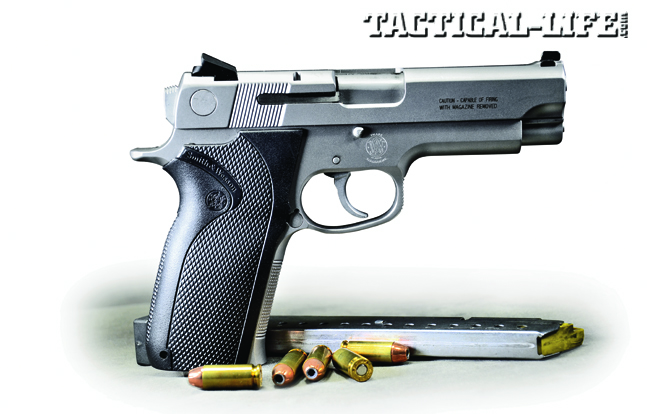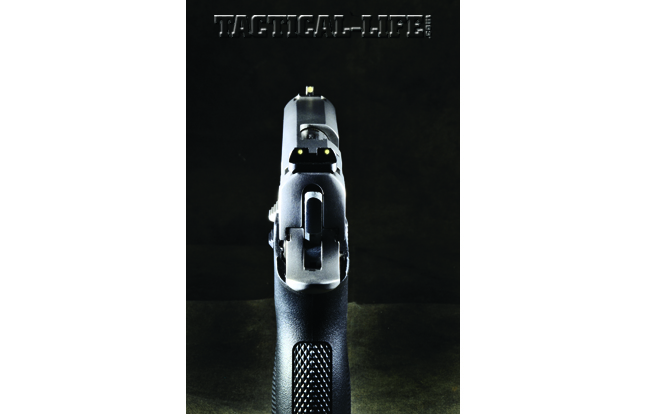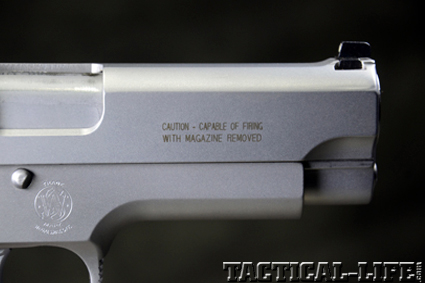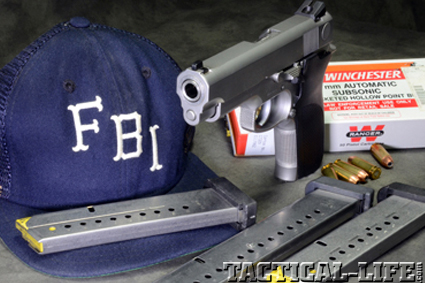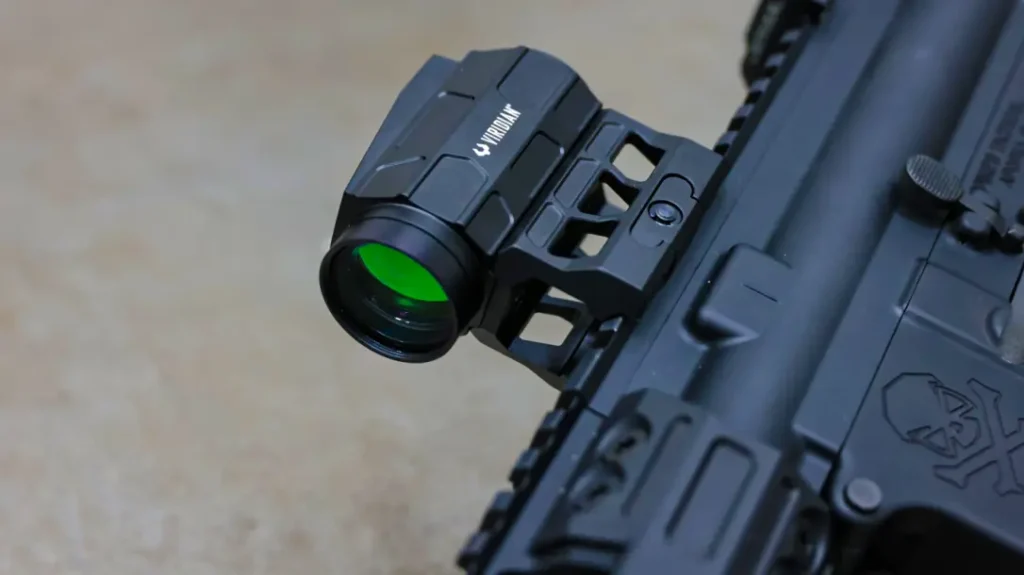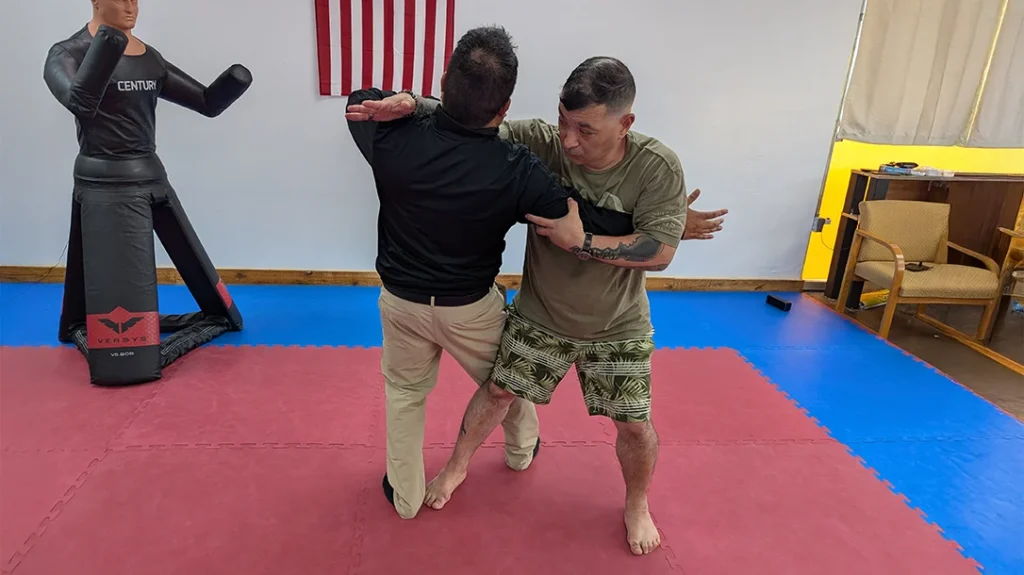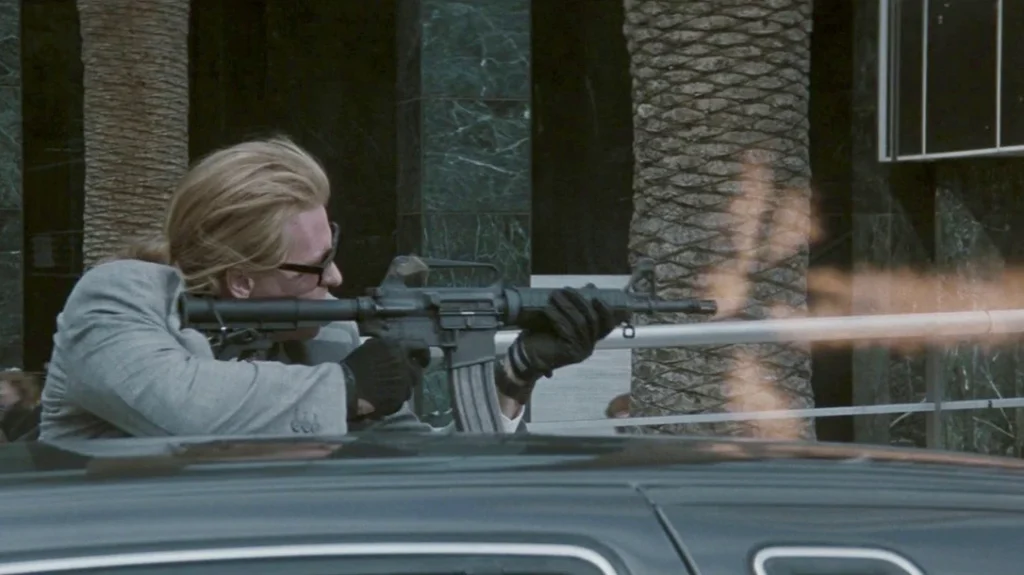The event that precipitated the FBI’s search for a new caliber and handgun took place on April 11, 1986, when agents attempted to arrest two ex-military bank robbers armed with a shotgun, a semi-auto carbine and a .357 Magnum revolver. The agents were armed with two shotguns, three Smith & Wesson Model 459 pistols and S&W revolvers. It should also be pointed out that only two of the agents were wearing body armor, and it was of a threat level designed to stop handgun—not rifle—rounds. Two agents were killed and three were seriously injured. Two other agents were injured, though not seriously. Both suspects were killed, one after being shot six times and one after being shot 12 times. Among the conclusions drawn during the FBI investigation of the shootout was that the handguns used by the agents lacked sufficient stopping power, thus allowing the suspects to keep shooting despite multiple hits. Eventually, Special Agent Edmundo Mireles Jr. ended the fight by approaching the FBI vehicle in which the severely wounded suspects were trying to flee and firing six rounds of .38 Special +P into them from his S&W Model 686 revolver. In all, approximately 145 shots were exchanged during the fight.
Later, it was realized that the suspect with the 5.56mm carbine had outgunned the agents. As a short-term measure, some Thompson SMGs were put back on the streets. A friend of mine who was on the St. Louis Bank Robbery Detail was carrying a cased Thompson in his trunk at one point. More stress, however, was put on obtaining a handgun round with greater penetration and stopping power. Some agents were authorized to carry .45 ACPs while the Bureau tested ammunition and weapons. Some carried the S&W Model 645 and the Sig Sauer P220.
In 1987, the Bureau had evaluated all currently available 9mm and .45 ACP pistols, but found none of them incorporated all of the features deemed desirable. In September 1987, the FBI sponsored a Wound Ballistics Workshop to determine the optimum cartridge. The primary conclusion reached: A bullet that would penetrate vital organs and create a larger hole would be the most effective. By December 1988, the FBI had begun testing ammo for penetration on soft targets and targets behind barriers.
Advertisement — Continue Reading Below
As a result of the tests, a 10mm load was developed as a compromise between those who advocated a large bullet (.45 ACP) and those who advocated a cartridge allowing a higher magazine capacity (9mm). In February 1989, the FBI director approved the adoption of the 10mm cartridge. This was followed in May 1989 by the offer to procure 9,500 10mm pistols. Colt and S&W submitted samples for testing, with S&W being awarded a contract in January 1990.
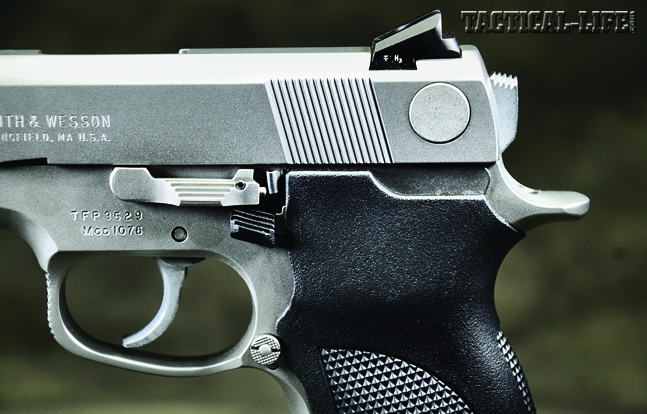
The FBI requested that the pistol’s external surfaces be black or matte. The mag release would have to be on the frame of the pistol, behind the triggerguard, and the magazines, whether loaded or empty, should drop free from the weapon when the mag release is pressed. The pistol had to be capable of firing the first round in the chamber when decocked (with the hammer down) by just pulling the trigger. The first-round, double-action (DA) trigger pull had to be between 10 to 12 pounds. Subsequent rounds should require a short, smooth trigger pull between 5 and 7 pounds. The FBI even specified a trigger slack of 0.19 inches (plus or minus 0.06 inches) in single-action mode prior to pressure being applied to the sear.
Advertisement — Continue Reading Below
The pistol also had to have fixed three-dot tritium night sights. The gun’s minimum desired capacity was 11+1, and each pistol had to be supplied with six magazines, plus one additional magazine holding “at least 50 percent more rounds than any of the other six magazines.” The magazines also had to have extended basepads. To allow more agents to comfortably handle the pistol, it had to come with two different grips or grip panels to fit different hand sizes. At least 50 percent of the grip frame surface below the triggerguard had to be checkered. Lastly, all exposed corners and sharp edges had to be rounded, and the magazine well needed to be beveled.
There were quite a few additional bid specs covering technical aspects of the pistol, which have not been listed, but the aforementioned should give a good idea of how much thought had been put into what the FBI desired for its new weapon. When evaluating the 1076, comparisons were made to the 3-inch-barreled S&W Model 13 that was the issued FBI weapon at the time. It was determined that the S&W 1076, the pistol adopted, was actually slightly shorter in overall length, about the same overall height and slightly thinner. It was heavier by a few ounces but held more rounds of a larger cartridge.
Advertisement — Continue Reading Below
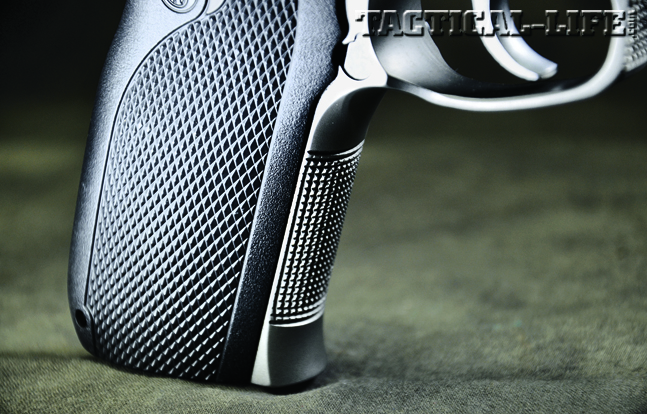
1076 Testing
Because S&W realized that an FBI order would generate great interest among other law enforcement agencies as well as civilian shooters, they gave the Bureau a bargain. Circa 1990, the 1076 would cost the FBI $295 for the pistol with standard night sights, three grip options and seven magazines (two 9-round, four 11-round and one 15-round). The FBI felt they could do transition training for agents at the rate of 100 per week, so that was the delivery schedule from Smith & Wesson.
The firearms instructors at each of the FBI regional offices were high-priority recipients of the 1076. I know that a friend of mine who was an instructor in the St. Louis office got one fairly early and called to ask me if I wanted to meet him at the range the day it came in. Of course I said yes. Since this was over 20 years ago, my memory isn’t perfect, but I think my instructor friend’s pistol came with some of the nine- and 11-round mags, but not a 15-rounder.
But I do remember some of my initial reactions to the S&W 1076. It felt somewhat heavy to me, as I had been carrying a Sig P226 with an alloy frame. However, it was well balanced and I found the weight a boon when we started shooting the 10mm loads originally adopted by the FBI. I don’t remember this for certain, but I am assuming these were the Federal loads using a 180-grain Sierra bullet designed to produce a muzzle velocity of 950 fps. Certainly, the combination of the S&W 1076’s weight and balance and the “FBI Lite” loads made the pistol pleasant to shoot.
Advertisement — Continue Reading Below
Another feature I liked was the decocker on the frame, as opposed to the normal S&W one on the slide. I remember quite a few agents liked this feature as well, since they had been carrying Sig P220s or P226s. I know the FBI bid specifications called for extra grips in different sizes, but I don’t remember extra grips coming with the gun we shot, but I do remember liking the grip installed. The checkering on the frontstrap kept the pistol from slipping in the hand, and I didn’t notice it when firing the FBI loads. I had a box of hotter 10mm loads that I had brought along, and I noticed the checkering when I fired those.
The sights were open enough that I could acquire them quickly and line them up well. I am assuming that the pistol we shot had night sights, but we shot in the daytime. I do remember that the DA and SA trigger pulls were good but not exceptional. We shot at 10 yards, 50 feet and 25 yards. My friend outshot me at every distance—he usually did. But my groups were more than satisfactory. We did some mag changes, and I liked the rubber-padded bases for slamming the mags home.
Advertisement — Continue Reading Below
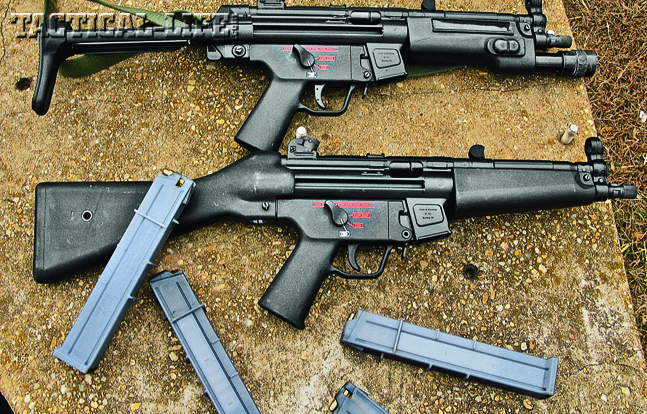
Moving Forward
I liked the 1076 quite a lot and wanted to get one of the commercial versions at the time. Some agents really liked the 1076 and some didn’t. As I remember, the agents I knew who were shooters and street agents usually liked the 1076, while those who just carried their pistol as a tool of the trade did not like it as much. That’s a generalization, of course. But I do know that when the 1076 was withdrawn from FBI service, there were some agents who fought hard to keep it, in some cases having to be threatened by higher-ups to get them to turn the pistol in.
One of the problems mentioned for the demise of the FBI 1076 was the insistence on a special trigger group designed to allow “prepping the trigger,” as was being taught at the FBI Academy at one point. In simple terms, “prepping the trigger” means that the shooter takes up trigger slack to the point where the trigger will start affecting the sear (i.e., the shooter notices resistance). Other sources deny that there was any special trigger group or that the FBI taught the technique at the time. The FBI manual for the 1076 counters this claim—it mentions prepping the trigger. I have read one report that stated the FBI required that S&W make the point of the trigger that contacted the draw bar longer to reduce take-up, and this caused pistols to lock up when the trigger would override the draw bar. Prepping the trigger may have contributed to the lockups. Whatever the cause, 1076 pistols were withdrawn and sent back to S&W. Once the lockup problem had been fixed, agents were allowed to purchase the pistols directly from S&W, and many did. Those not purchased by agents seem to have been sold to distributors by S&W.
Worth Collecting
S&W seems to have easily corrected the problem, but the FBI had moved on from the 1076. I liked the pistol when I first encountered it, and I still liked it when I handled one for this article. I have to admit I choked up just a bit as I wrote this article, as my friend who allowed me to shoot one of the first 1076s that came into the St. Louis FBI office died a couple of years ago, but I also had some good memories of a pleasant afternoon shooting the new Bureau pistol. For S&W semi-auto collectors, the FBI 1076 is a highly coveted prize. Unlike many FBI weapons, which were destroyed when removed from service, because the 1076s went back to S&W and were sold to individual agents and other LEOs, they occasionally turn up on the collector’s market—lucky collectors!
Advertisement — Continue Reading Below
The FBI’s Heckler & Koch MP5/10
In addition to adopting a more powerful handgun load, the FBI also wanted a submachine gun with a cartridge more powerful than the 9mm. As a result, an order was placed with Heckler & Koch for a 10mm version of the MP5. Among differences from the standard MP5 was the incorporation of a bolt hold-open, with a bolt catch lever that could be operated to allow the bolt to go forward after a reload. The addition of the hold-open required the MP5’s receiver to be modified to leave space for the device. The trigger group also had to be altered to allow for the installation of the bolt catch. The standard trigger group for the MP5/10 had the three-round burst mode. MP5/10 muzzles were threaded for a suppressor. Another change was the use of a flapper magazine release located behind the mag well instead of the release button standard on the HK MP5.
Running Hot
Although many parts are interchangeable between the MP5 and the MP5/10, some are not. For example, the MP5/10 uses the recoil spring from the 5.56mm NATO HK53. Also, the bolt head is designed to engage the larger 10mm round, and, by making the rollers on the bolt head shorter, the center of the bolt head was lowered to allow for greater contact with the 10mm rim to enhance reliability. To allow for use of either the hot 10mm or FBI Lite loadings, HK offered two different locking pieces for the bolt group. The SMG’s straight mags were made of translucent polymer.
I have seen reference to the FBI ordering 5,000 MP5/10 SMGs, but I don’t know if all were delivered. Most were withdrawn at the point when the FBI went to 5.56mm M4 carbines, but at least some remain in use with the FBI HRT and perhaps some regional SWAT teams. For the most part, though, the 10mm SMG has gone the way of the 10mm pistol with the FBI.
Advertisement — Continue Reading Below
For More Information
Smith & Wesson
smith-wesson.com; 800-331-0852
Heckler & Koch
hk-usa.com; 706-568-1906

